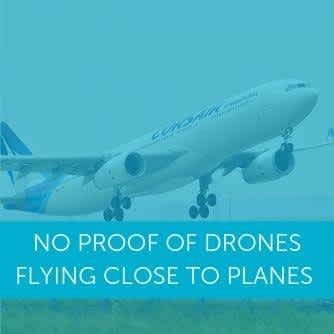
Updated on • 18 Aug 2024
No proof of drones flying close to planes in UK - FOI report
No proof of drones ever flying close to manned aircraft in UK skies, FOI reveals. Also, new report shows drone not to blame for damage to plane in Mexico. ... Read More
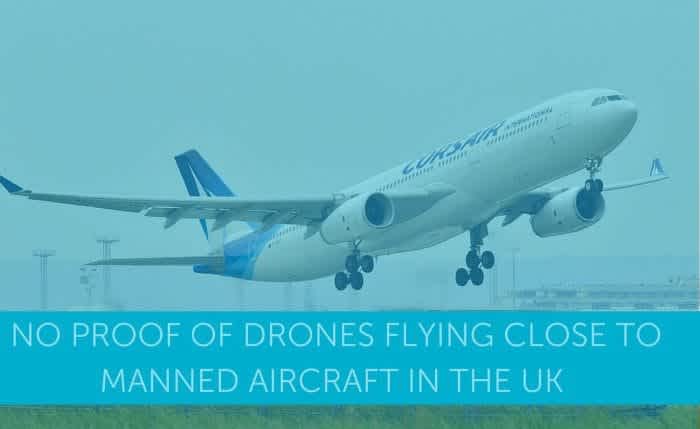
There is NO concrete proof that a drone has ever flown close to manned aircraft in UK skies, a Freedom of Information (FOI) request has revealed.
This statement has been obtained by the Airprox Reality Check group - formerly known as the Flight Safety Board - following an FOI request to the UK Airprox Board (UKAB), whose primary objective is to enhance air safety in the UK and collate Airprox (near miss) reports.
The FOI request also revealed that there is NO confirmation that a drone has ever been involved in any of the 350+ drone Airprox reports which the Board has published to date.
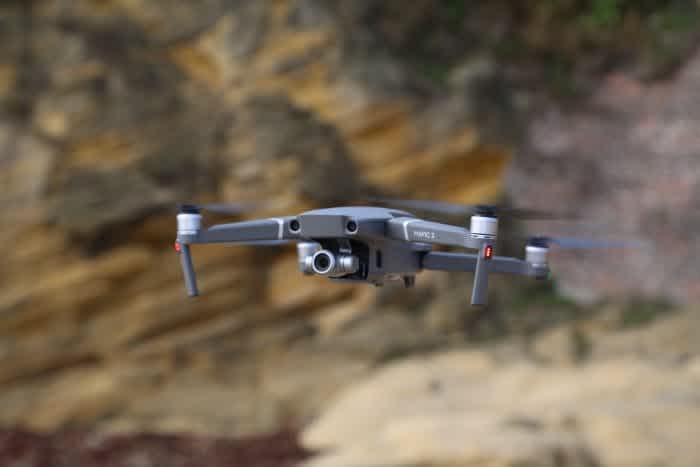
There is no concrete proof that a drone has come close to hitting a manned aircraft in the UK.
The formal response states:
.. in the case of pilot-reported drone/object Airprox, it has never yet been the case that an associated drone operator has been identified, so the available information is limited to that provided by the pilot and controller involved. Therefore, for the manned-pilot reported Airprox, in all cases UKAB has no confirmation that a drone has flown close to an aircraft other than the report made by the pilot(s). Similarly, other than from the report of the pilot(s), UKAB has no confirmation that a drone was involved.
FOI statement
The FOI request follows a spate of dubious reports - and subsequent media hysteria - about drones coming close to or even colliding with manned aircraft.
One such example came in April, when an Airprox report stated that a Virgin Atlantic plane faced a collision with two drones at a whopping 14,000ft as it was approaching Heathrow Airport to land - based purely on an eye-witness account from the Cabin Crew Manager!
As you can imagine, this prompted a host of negative press, typical of the UAV (unmanned aerial vehicle) scare-mongering and blame tactics which have been doing the rounds of late!
In contrast, experts in the drone industry - including Heliguy - tried to explain why it was highly unlikely that drones were to blame for this incident.
"Unsubstantiated, and often bogus, Airprox reports feed high profile media stories, which in turn creates a false climate of drone fear. When something goes wrong everyone involved has been pre-programmed to jump to the same (incorrect) conclusion. Drone! And the more it happens, the worse it gets." That's the view of Simon Dale, of Airprox Reality Check.
These FOI findings come on the back of a recent investigation which proved that damage to a Grupo Aeromexico SAB airliner in Mexico last December was NOT caused by a drone - despite media reports to the contrary - and was, in fact, the result of a poorly-done repair.
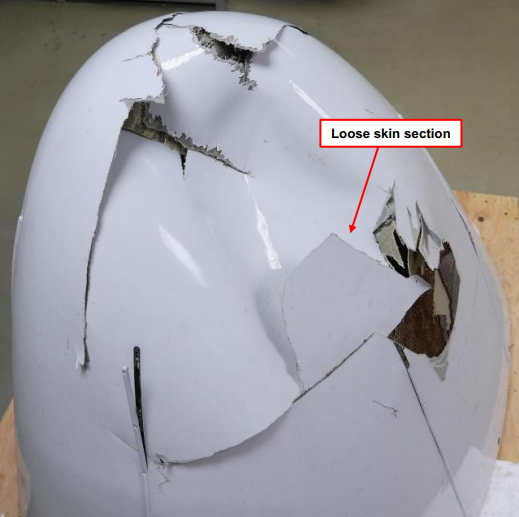
The damage to the Grupo Aeromexico SAB airliner, which was allegedly caused by a drone but a subsequent investigation has proved otherwise. Picture taken from Boeing's EQA report.
Reaction From The Industry
Make no mistake, this news is a huge boost for the drone industry, which has taken something of a battering of late.
Mass hysteria has tarnished the reputation of drones, which seem to have become a bogeyman of the 21st century. Such negative press - often based on scant concrete evidence - has no doubt led to a noose being put around the necks of drone operators, with harsher laws coming into force and the possibility of the controversial Drone Registration Scheme - complete with annual charge - being implemented towards the end of the year.
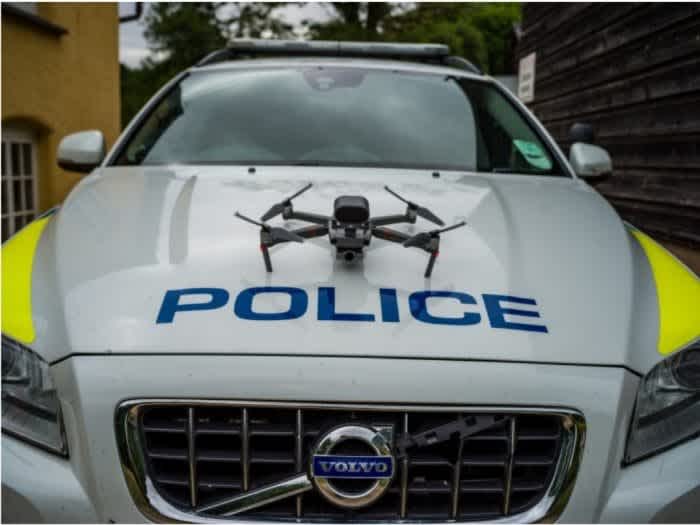
Police are being given greater powers to deal with rogue drone use.
With this in mind, those in the drone industry have jumped on the back of the FOI findings, revelling in the fact that there is no hard evidence to suggest a drone has come into close contact with manned aircraft in UK skies.
"I would say I'm pretty shocked by this, however, this only confirms what's pretty obvious to all those in the industry," says Matt Bailey from drone manufacturer DJI.
Simon Dale, of Airprox Reality Check, said: "We have the crazy situation where completely unproven, unscrutinised, 'UFO' reports (which often describe drones being spotted at altitudes and locations that are impossible) have been used by the Government to drive regulation, as if they were solid, proven, facts. They are, in fact, totally uncorroborated eyewitness accounts, and are generally based on the simple errors of perception to which humans are prone.
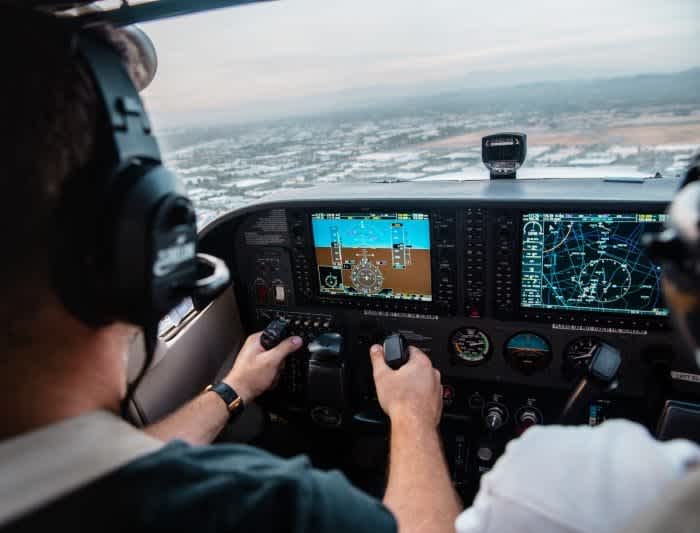
"In several cases, we have shown that the object observed was, in fact, a manned aircraft in the distance, not a drone at all.
"The Government is mid-way through introducing legislation based on this now-discredited data. Given that it is now clear that the drone Airprox reports are entirely unproven, and in the vast majority of cases, entirely bogus, the Government must recognise the huge mistake it has made, and cancel the proposed regulations before they do irreparable harm to the drone industry, model flying community, and, in the longer term, the whole aviation sector."
Responding to the FOI news, Matt Bailey, Senior Communication Manager at DJI, took to LinkedIn to express his thoughts. He posted:
I would say I'm pretty shocked by this, however, this only confirms what's pretty obvious to all those in the industry. Keep up the great work Simon Dale and team. As Brendan Schulman (DJI's Vice-President of Policy and Legal Affairs) said: "When the public, media and regulators focus on outrageous incidents that did not occur, it draws attention away from risks that are less sensational but more prevalent.” Let's start concentrating on the real issues. #dronesforgood
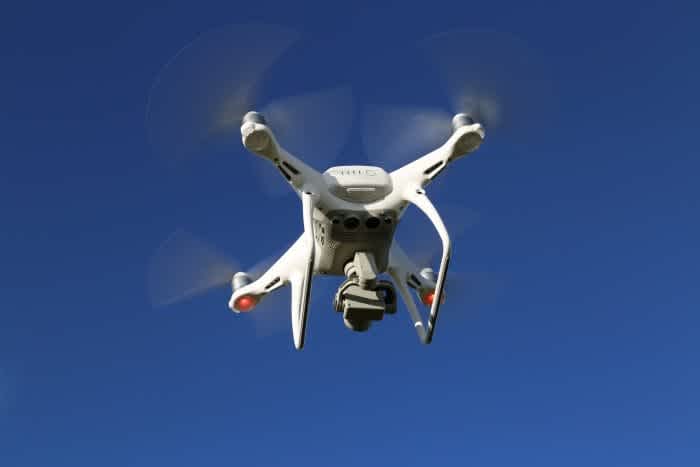
How An Airprox Is Reported
Once an Airprox notification is received, the UKAB's administrative team notify the inspector team who make a preliminary assessment of whether the incident is an Airprox or not. If the inspectors confirm that the incident is an Airprox, then the notification is logged in the UKAB system and allocated an Airprox number for tracking.
When a drone near-miss is reported by an eye-witness, the UKAB says that it takes a pragmatic approach
The administrative team then notify the radar analysis cell at NATS (National Air Traffic Agency) Swanwick who view any available associated NATS radar recordings based on the reporter’s reported location and time to confirm reporting aircraft details and see whether there is any display of primary radar returns that might be associated with a drone or other aircraft at that time and location.
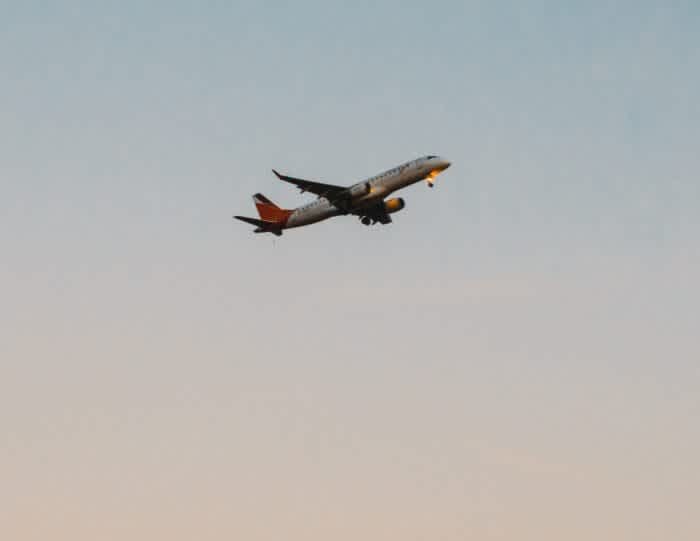
However, in the case of pilot-reported drone/object Airprox, the FOI states that it has never yet been the case that an associated drone-operator has been identified, so the available information is limited to that provided by the pilot and controller involved.
In this case, the Board notes the information and provides any views in the knowledge that identification of the drone/object and assessment of risk are subject to a degree of interpretation. In this respect, the Board 'adopts a pragmatic approach' wherein if a pilot can positively identify the object as a drone (e.g. number of rotors, recognition of a particular type) then the reporter’s identification is 'taken at face-value'.
The CAA has said that anyone who operates a drone should do so responsibly
If a reporter can only describe the object in generic terms (e.g. a rectangular object) then UKAB classify it as an unknown object. The UKAB will then decide on the amount of risk of collision - from very close to non-existant.

UKAB is sponsored jointly, and funded equally, by the UK Civil Aviation Authority (CAA) and the UK Military Aviation Authority (MAA).
Heliguy asked the CAA to comment on the FOI report. In response, a CAA spokesperson said:
It is illegal to fly drones close to airports and anyone flouting the rules can face severe penalties including imprisonment. Anyone operating a drone must do so responsibly and observe all relevant rules and regulations. The rules for flying drones are designed to keep all airspace users safe. The CAA's Dronecode provides advice on how to fly your drone safely and follow the rules. you can see it at www.dronesafe.uk
Drone Not To Blame For Damage To Plane In Mexico
As mentioned earlier, this FOI statement comes just days after it was revealed that a drone was not to blame for damage caused to a plane as it landed in Mexico.
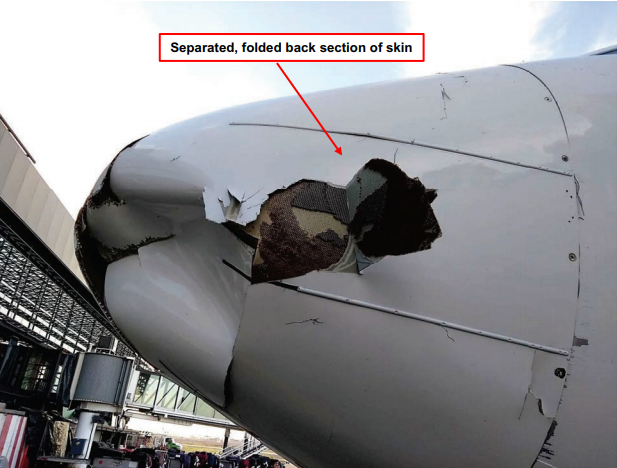
Damaged radome prior to removal from the aircraft. Picture taken from Boeing's EQA report.
Following the incident, which occurred on December 12, 2018, there was much negative press attention, with the media rushing to blame a UAV for damaging the airliner's radome (a dome or other structure protecting radar equipment and made from material transparent to radio waves, especially one on the outer surface of an aircraft).
But this has now been ruled out by experts in Boeing's Equipment Quality Analysis (EQA) laboratory, who have stated that the real reason was likely a poorly-done repair on the plane which caused its nose to collapse and crack as it prepared to land.
Furthermore, the EQA report adds that there is NO indication of a 'hard-body impact' from any object - ie a drone - or bird.
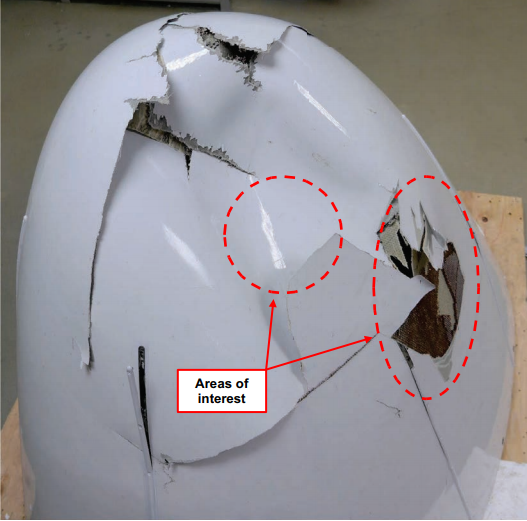
Radome bottom left view. Picture taken from Boeing's EQA report.
This report will be sent to the DGAC (Directorate General of Civil Aeronautics) of Mexico, which is investigating the incident.
To go into a bit more detail, the report states:
The review showed that an interface seal was installed around the entire periphery of the radome with no openings. This configuration lacked the approximately eight-inch opening in the seal along the bottom of the radome interface specified in engineering drawings and the Airplane Maintenance Manual radome installation task. This opening in the seal is required to allow the radome area to drain and for equalisation of pressure changes across the radome during flight. A review by our engineering team concluded that the lack of this gap likely resulted in differential pressure across the radome during descent which may have contributed to an internal collapse of the radome.
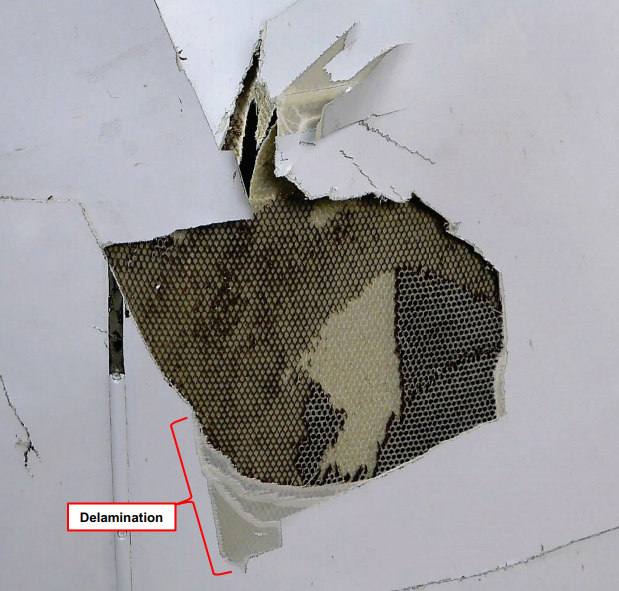
View showing area of separated skin ply section. Picture taken from Boeing's EQA report.
Ruling out an impact with a drone, the report adds:
No indications of a hard body impact were evident on the radome. No snarge (blood or tissue), indicative of a bird strike, was present. Inspection of the indentation noted no evidence of an impact. The impact of a hard-bodied, or manmade, object was ruled out due to a lack of distinctive marks in the radome surface. No blood or tissue (snarge) from a bird strike was evident. An alcohol swab was used to collect potential DNA evidence for analysis using the Smithsonian Institution Feather Identification Lab instructions, available from the Federal Aviation Administration.
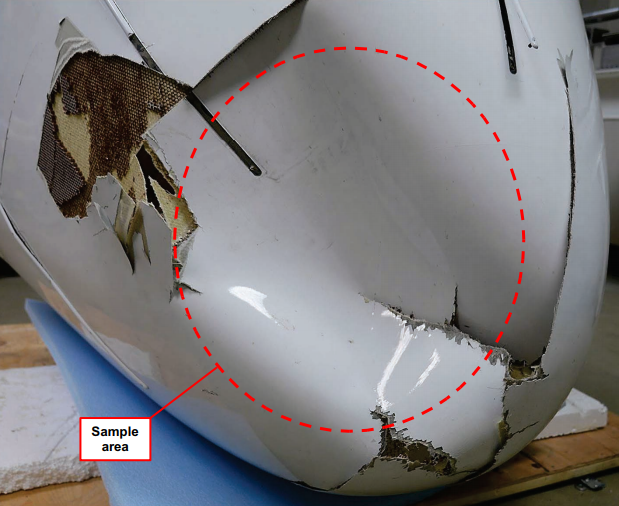
Overview showing sample area. Picture taken from Boeing's EQA report.
Not The First Time That Drone Reports Turned Out To Be Wrong
The incident in Mexico is the latest in a long line of cases where drone blaming has turned out to be wrong.
As we have seen with previous cases, people have had a tendency to point to drones as culprits. But there have been many stories where reports of UAVs wreaking havoc have ended up being wrong, with the actual villains turning out to be a plastic bag (UK, 2016), a bat (Australia, 2017) and a balloon (New Zealand, 2018).
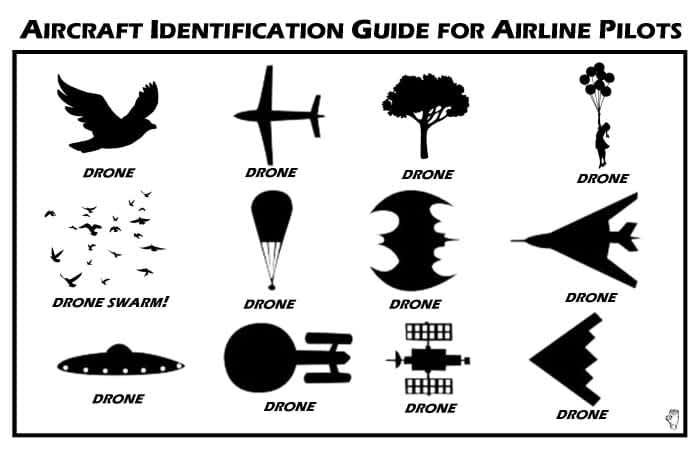
This joke drone identification chart sums up the current state of play! Taken from hackaday.com
Even the much-publicised Christmas-time disruption at Gatwick Airport might not have been caused by a drone, with a senior police officer saying in the days after the chaos that there was a 'possibility' there had never been a drone.
Previous incidents where a drone has been blamed have turned out to be false, with the actual items ranging from a plastic bag to a balloon
Then there was the incident at Newark Airport in January. Officials with the Federal Aviation Administration (FAA) said that they received two reports of possible drones operating nearby, one from a Southwest Airlines pilot and the other from a United Airlines pilot who spotted what they believed was a drone in the air as they prepared to land. But later, an FAA spokesman said that the agency had been unable to independently confirm the sightings.
At the time, industry experts pushed back against the reports, claiming that the objects could have been balloons, plastic bags or space junk. Adam Lisberg, spokesman for DJI, questioned the drone sightings in a tweet, asking how pilots in a plane travelling 250mph could see something the size of a dinner plate at 3,500ft. He added: ‘Whatever they saw, it probably wasn’t a drone.’
A Sweet Victory For The Drone Industry
The fact that there is no concrete evidence to suggest that a drone has nearly collided with a manned aircraft in the UK is a sweet victory for the industry.
Hopefully this, as well as the fact that a UAV was not to blame for the incident in Mexico, will help to build the public's confidence in drones and show that, in many cases, they are being unfairly blamed. Put simply, the scapegoating of drones has to stop!
After all, drones are playing a vital role in a wide range of commercial sectors, including the emergency services, construction, infrastructure and agriculture - helping to save time, cut costs, increase safety and in some cases, save lives.
Emergency-services-700x525.jpg
Agriculture-ent-700x394.jpg
image.png
Despite all of this though, there is still bound to be apprehension about drones in some quarters. To help mitigate and deter rogue UAV pilots, Heliguy specialises in drone detection, helping the likes of airports, prisons and stadiums arm themselves with suitable technology to combat a potential threat. After all, the incident at Gatwick showed just how costly a drone attack can be.

written by
James Willoughby
James joined heliguy™ in 2018 following a 13-year stint in print and online journalism, having worked on regional and weekly newspaper titles. He is responsible for spearheading heliguy™'s content strategy and social media delivery. James collaborates with DJI Enterprise's European marketing team to coordinate and produce case studies and helps organise events and webinars.